THEORY AND METHOD
Very often, I choose to ground drive a colt before I put the first ride on them. However, if I feel that they have progressed sufficiently through their ground work, I have an exceptional deal of control over their feet, good lateral flexion, and can sack them out, I may just hop on.
Basically, if you have a good foundation on your horse, getting on for the first time should be a non-event. Now, as we all know, horses are predictably unpredictable. Some horses, no matter how much you prepare them, will react when you get on for the first time. It's a new feeling for them, and they can get claustrophobic when they feel your legs on either side of their body. What your ground work does, however, is give you a good idea of how your horse will react when you do step on the first time.
By this point in your training, your colt should be used to you being up above him. He should stand quietly while being sacked out. He should know how you yield every part of his body softly with little to no resistance. He should have learned that bucking is not an appropriate response, and the only way to get rid of pressure is to stop bucking. If your colt knows these things, there is a better chance of the first ride going well.
I choose to start off bareback. I've ridden far to many colts that have been ill-prepared for riding. As a result, they've done some acrobatics to try and get rid of me! A good number of them have opted to go up and over. With a western saddle on, I've been lucky to get away with just minimal injury... a hairline fracture to my hip. When you are riding bareback, it is far easier to bail out if something goes wrong. It also tends to keep me more honest. If I know I am getting on a colt bareback, you can bet I'm more apt to put in the time it takes on the ground first!
How much we do on the first ride depends a lot on the colt. I prepare by going through the exercises he has already learned. When he is in a good frame of mind, is nice and relaxed, then I'll start.
First mounting
Because my colts are all used to my hanging over their backs, that's where I'll start. From my block (because, again, I'm not such a good jumper!), I'll hop up and drape my belly over the colt's back. With my left hand, I'll flex his head slightly towards the left. This way, if he acts up, I can step down and get his hips moving away from me.
So long as he remains relaxed, I'll move on. I swing both my feet up on top of the colts rump. Moving my boots around gives me an idea of how my colt will react. Again, so long as everything feels quiet underneath me, I'll keep going. I try to move slowly, but deliberately; don't tiptoe around your colt, or move so slowly that you just annoy or 'tickle' the horse. Slide your left leg into position, keeping your upper body down against the neck. Slide your right leg into position. Gradually straighten up. Congratulations! You are on your colt!
Checking in
Now that you are up there, you need to check in with your colt. Keep your body relaxed, don't grip tightly with your legs as it may scare him. Just like you did from the ground, flex your horse's head from side to side. Start slowly; expect a lot, but accept a little. The first inch of flexion is always the hardest to get. Take your time to get this as good as you can, it's your safety net if you need to stop your colt.
The ride
Some horses won't stand still for flexing when you first get on, and that's fine. If he feels he needs to move his feet, I'll let him. While he is moving, however, I will keep him flexed. In the beginning, I will flex more, but as he gets comfortable, I'll start to let him straighten up.
Many colts, however, are unbalanced and nervous their first few rides. They are not confident enough to step out without encouragement. For these colts, I sit up nice and straight (without being tense). I use a voice command that they should already know from ground work. Keeping the neck flexed slightly, I'll start tapping my hand on my chaps to make some noise. This is often enough to get their feet going a bit. If not, then I'll start to use gentle leg pressure, remembering that legs are totally foreign still. What is important is that the INSTANT the colt steps forward, to release the pressure. If all I get on the first ride is a step or two, I'm happy!
Dismount
Some colts are more bothered by the dismount than by the first mounting!
I tend to think it's because they become startled when you go to step down, as you've probably been sitting relatively still for a while. So, to counter this, I start by flexing the neck, so I have some control. I then start moving my legs around, first on one side, then on the other. Basically, I'll just reverse the mounting procedure. Lowering my upper body, I'll bring my right leg up and rest it on top of the horse's back. I can then slide my self off safely.
At this point, I will usually get on the colt from the other side and repeat the whole procedure. When I get on from the right, I tend to flex the colt to the right for the whole ride. When I get on from the left, I flex to the left.
Before you make the first ride, you really need to take a good look at your riding ability. If you aren't comfortable or confident enough to ride your colt, no matter what happens, you may want to reconsider putting the first ride on him. Use common sense and keep your safety in mind!
Please use caution and common sense. Horses are large animals, with an exceptional amount of power and strength. They are also concerned above all with their own personal safety, and will do whatever they feel it takes to keep themselves from harm. Being individuals that act and react differently, the only certainty you have when working a horse is uncertainty. I am a professional trainer with twenty plus years experience, yet even with the knowledge I possess, I still get hurt from time to time. This blog and the accompanying media are for entertainment purposes only. No responsibility will be assumed for injuries or damages incurred while trying to use these methods at home. Please ride responsibly; protective gear can save your life!
 Stevie relaxing on the bridge, with my "assistant", Nick, a three year old colt. I like to have lots of distractions for my colts when I am working, and a loose horse in the ring is certainly one!
Stevie relaxing on the bridge, with my "assistant", Nick, a three year old colt. I like to have lots of distractions for my colts when I am working, and a loose horse in the ring is certainly one!




















































